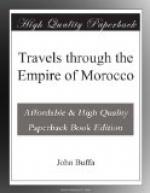The Moors, in general, are extremely fond of fruit and vegetables, which contribute very much to their contentment. The peasants eat meat only on certain great days. They are excessively dirty in their cooking, and the style of their dishes is not at all adapted to the taste of an Englishman. Their soups are made most intolerably hot with spices; and their favourite dish is cous-ca-sou, which appears to me to be prepared in the following manner: The meat and vegetables are laid alternately in a large bowl, and seasoned; then the whole is covered with fine wheaten flour, made into small grains, very like the Italian pastes. It is raised into the form of a pyramid, and I should imagine stewed, or rather steamed, as the outside remains perfectly white, which it would not were it baked. The whole of the inside, when brought to table, is mingled almost into one mass; the meat separating from the bones, without the smallest difficulty: it does not contain any gravy, and the Moors eat it by handsfull.
I generally live upon mutton and veal, both of which are very good: the bread and butter are excellent, but the latter will not keep more than twenty-four hours without becoming rancid. My greatest annoyance here is the infinite number of bugs and fleas, which infest me by day and night most intolerably.
LETTER XIV.
Fez—Debility of the Moors—Mosques—Antiquities, Roman, Carthaginian, and Saracen—Storks held in great Veneration—Baths— Bazars—Inhabitants—Residence—Menagerie—Marvellous Preservation of a Jew—Lions—Tigers—Leopards—Hyenas.
Fez, ——.
Considering the mildness of the climate, the uncommon fertility of the soil, the number of mineral waters, the fragrancy and salubrity of the air, one would imagine that the frame and constitution of a Moor cannot but be beautiful, strong, and healthy; yet, though the most handsome people of both sexes are to be met with in this great city, the number of miserable objects, the wretched victims of excessive early passions, is in a much larger proportion: it is shocking beyond description to meet them in every corner of the streets. I have visited a great many of these poor creatures, and found them in such a state, that decency obliges me to draw a veil over it.
The mosques of this town, which I have before mentioned as very numerous, are square buildings, and generally of stone; before the principal gate there is a court paved with white marble, with piazzas round, the roofs of which are supported by marble columns. In niches within these piazzas, the Moors perform their ablutions before they enter the mosques. Attached to each mosque is a tower, with three small open galleries, one above another, whence the people are called to prayer, not by a bell, but by an officer appointed for that duty. These towers, as well as the mosques, are covered with lead, and adorned with gilding, and tiles of variegated colours. No woman is allowed to enter the Moorish places of worship.




